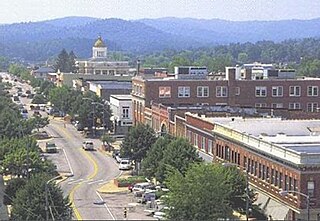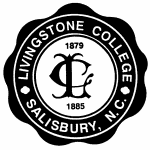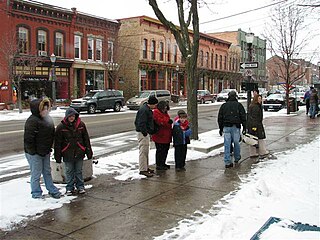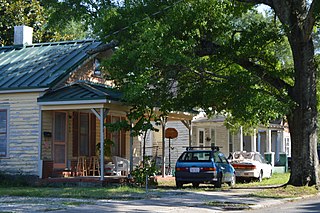
Hendersonville is a city in Henderson County, North Carolina, United States. It is 22 miles (35 km) south of Asheville and is the county seat of Henderson County. Like the county, the city is named for 19th-century North Carolina Supreme Court Chief Justice Leonard Henderson.

The John C. Campbell Folk School, also referred to as "The Folk School", is located in Brasstown, North Carolina, along the Cherokee County and Clay line. It is a non-profit adult educational organization based on non-competitive learning. Originally founded with an emphasis on agriculture and "the doing of life's work," the Folk School now offers classes year-round in over fifty subject areas including art, craft, music, dance, and nature studies. Established in 1925, the Folk School's motto is "I sing behind the plow".

Livingstone College is a private historically black Christian college in Salisbury, North Carolina. It is affiliated with the African Methodist Episcopal Zion Church. Livingstone College is accredited by the Southern Association of Colleges and Schools to award bachelor's degrees.

College Hill is a neighborhood in the west central section of the United States city of Greensboro, North Carolina. College Hill was Greensboro's first neighborhood.

Located in the northern end of Lansing, Michigan, Old Town overlooks the Grand River and a winding bike trail. Listed on the National Register of Historic Places as the North Lansing Historic Commercial District, the district was established in the mid-19th century.

There are 75 properties listed on the National Register of Historic Places in Albany, New York, United States. Six are additionally designated as National Historic Landmarks (NHLs), the most of any city in the state after New York City. Another 14 are historic districts, for which 20 of the listings are also contributing properties. Two properties, both buildings, that had been listed in the past but have since been demolished have been delisted; one building that is also no longer extant remains listed.

North River Mills Historic District is a national historic district located at North River Mills, Hampshire County, West Virginia. The district encompasses 25 contributing buildings and five contributing sites. The district lies along Hiett Run, which empties into the North River, a tributary of the Cacapon River. It has become an industrial ghost town, now visited only by summer residents and tourists. The contributing buildings include the Hiett House with shed and privy; Croston House and barn ; North River Mills Grocery ; Shanholtz House, also known as North River Mills Society for Antiquarian Arts and the Diffusion of Knowledge; North River Mills School ; Miller House and associated outbuildings; United Methodist Church ; Kump House ; and the Moreland House. Contributing sites are the cemetery associated with the Kump House, Miller Mill Site, Shanholtz Mill Site, mill pond, and millrace.

Halifax Historic District is a national historic district located at Halifax, Halifax County, North Carolina, US that was listed on the National Register of Historic Places in 1970. It includes several buildings that are individually listed on the National Register. Halifax was the site of the signing of the Halifax Resolves on April 12, 1776, a set of resolutions of the North Carolina Provincial Congress which led to the United States Declaration of Independence gaining the support of North Carolina's delegates to the Second Continental Congress in that year.

Mooresville Historic District is a national historic district located in Mooresville, Iredell County, North Carolina. It encompasses 62 contributing buildings and 8 contributing sites in the central business district and surrounding residential sections of Mooresville. The district includes notable examples of Italianate, Romanesque Revival, and Renaissance Revival architecture. Notable buildings include the Mooresville depot, the former Lorene Cotton Seed Oil Mill, First Presbyterian Church (1899), McLelland House, D. E. Turner Hardware Co. store, the former U. S. Post Office, and the McKnight Pontiac-Buick Co..
Downtown Asheville Historic District is a national historic district located at Asheville, Buncombe County, North Carolina. The district encompasses about 279 contributing buildings and one contributing object in the central business district of Asheville. It includes commercial, institutional, and residential buildings in a variety of popular architectural styles including Colonial Revival, Queen Anne, and Art Deco.

Mount Pleasant Historic District is a national historic district located at Mount Pleasant, Cabarrus County, North Carolina. The district encompasses 98 contributing buildings and 3 contributing structures in the town of Mount Pleasant. It includes residential, institutional, and commercial buildings in a variety of popular architectural styles including Victorian, Colonial Revival, and Bungalow / American Craftsman. Notable buildings include the Jacob Ludwig House, Kindley Mill Village houses, Saint James Evangelical and Reformed Church, Lutheran Church of the Holy Trinity, Mount Pleasant Milling Company, Kindley Cotton Mill, and Tuscarora Cotton Mill.

Hope Mills Historic District is a national historic district located at Hope Mills, Cumberland County, North Carolina. It encompasses 61 contributing buildings and 3 contributing sites in the central business district of Hope Mills. Ii includes industrial, commercial, religious, and residential buildings and includes notable examples of Federal and Late Victorian style architecture. Notable buildings include the (former) Hope Mills Manufacturing Company buildings, Rockfish Manufacturing Company, Colin MacRae House, Christ Episcopal Church, Lebanon Masonic Lodge No. 391, and Alice L. Gilbert Store.
Cooleemee Mill Town Historic District is a national historic district located at Cooleemee, Davie County, North Carolina. The district encompasses 433 contributing buildings, 1 contributing site, and 6 contributing structures on the original Cooleemee Cotton Mill Company property at Cooleemee. It was developed between 1898 and 1967, and includes notable examples of Gothic Revival, American Craftsman, and Colonial Revival style architecture. Notable contributing resources include the mill houses of 12 house types, Cooleemee Cotton Mill complex, Pest House and the company farm, Friendship Baptist Church, North Cooleemee Elementary School (1952), Church of the Good Shepherd (1925), Cooleemee United Methodist Church (1932), First Baptist Church of Cooleemee (1949), Cooleemee Recreation Center Bathhouse (1949), “The Holler,” and “Riverside Park,” also known as “Park Hill.”

Sunnyside–Central Terrace Historic District is a national historic district located at Winston-Salem, Forsyth County, North Carolina. The district encompasses 425 contributing buildings in a predominantly residential section of Winston-Salem. The buildings date from about 1892 to 1958, and include notable examples of Colonial Revival, Late Victorian, and Bungalow / American Craftsman style architecture. Notable buildings include the Arista Mills (1950), Farmers Cooperative Exchange, Southern Steel Stampings, E. T. Baity Oil Co., Central Terrace Methodist Church, and Pine Chapel Moravian Church (1928).

Roanoke Rapids Historic District is a national historic district located at Roanoke Rapids, Halifax County, North Carolina. It encompasses 1,130 contributing buildings, 5 contributing sites, 27 contributing structures, and 1 contributing structure in the central business district and surrounding residential sections of the town of Roanoke Rapids. The district includes notable examples of Queen Anne, Colonial Revival, and Bungalow / American Craftsman style architecture. Located in the district is the separately listed Roanoke Rapids High School. Other notable buildings include workers houses in four local mill villages, Driscoll-Piland-Webb House, Dickens-Webb House (1906-1907), Samuel F. Patterson (1914-1915), Council-Coburn House (1925-1927), First Presbyterian Church (1915), All Saints Episcopal Church designed by Hobart Upjohn (1917), (former) First Baptist Church (1928-1929), (former) Nurses Home and School (1930-1931), Clara Hearne Elementary School (1933-1935), (former) North Carolina National Guard Armory (1940-1941), (former) United States Post Office (1937-1938), Rosemary Drug Co. Building (1915-1916), Shelton Hotel, First National Bank Building (1914-1915), J. C. Penney and Co. Building (1938-1942), McCrory Co. Building (1940), Imperial Theatre Building, (former) Seaboard Air Line Passenger Station (1917), Rosemary Manufacturing Company complex, Patterson Mills Co. (1910), and Roanoke Mills Co. Plant No. 2. (1916-1917).
Mitchell College Historic District is a national historic district located at Statesville, Iredell County, North Carolina. It encompasses 336 contributing buildings and 1 contributing site associated with Mitchell Community College and the surrounding residential area in Statesville. The district includes notable examples of Greek Revival, Queen Anne, and Classical Revival architecture dated between about 1885 and 1930. Located in the district is the oldest building and separately listed; the Main Building, Mitchell College (1854-1856). Other notable contributing resources are the Fourth Creek Burying Ground, George Anderson House, Friends Meeting House, Broad St. Methodist Church (1907), Congregation Emmanuel Synagogue (1891), McRorie House, Dr. Tom H. Anderson House, Dr. Julius Lowenstein House, Ludwig Ash House, L. N. Mills House (1925), Mills Apartment, R. A. Cooper House (1920), Statesville Woman's Club (1927), and the former Davis Hospital.

West Selma Historic District is a national historic district located at Selma, Johnston County, North Carolina. It encompasses 217 contributing buildings, 1 contributing site, and 1 contributing structures in predominantly residential section of Selma. It includes notable examples of Queen Anne, Gothic Revival, Moderne, and Bungalow / American Craftsman style architecture and buildings dating from about 1880 to 1961. Located in the district is the separately listed Nowell-Mayerburg-Oliver House and William E. Smith House. Other notable buildings include the Edgerton Memorial Methodist Episcopal Church, Abdalla House, Dr. Joshua W. Vick House, Stella and William H. Etheridge House, Dr. R. Marvin Blackmon House, Samuel P. Wood House (1935), Janie and C. E. Kornegay House (1923), Selma Presbyterian Church, St. Gabriel's Episcopal Church/Vernon Wiggs House, and Pepsi Bottling Company.

Hawkins Avenue Historic District is a national historic district located at Sanford, Lee County, North Carolina. It encompasses 200 contributing buildings and 4 contributing structures in a predominantly residential section of Sanford. The district includes notable examples of Colonial Revival and Queen Anne style architecture, with buildings largely dated between about 1900 to the 1930s. Located in the district is the separately listed Sanford High School, Former. Other notable buildings include the John McIver House (1880s), Duncan E. McIver House (1893), Malcolm D. McNeill House, E.L. Gavin House (1922), First Presbyterian Church of Sanford (1914), First Baptist Church (1925), the former Sanford Cotton Mill complex, and the Liles Bonded Cotton Warehouse.


















